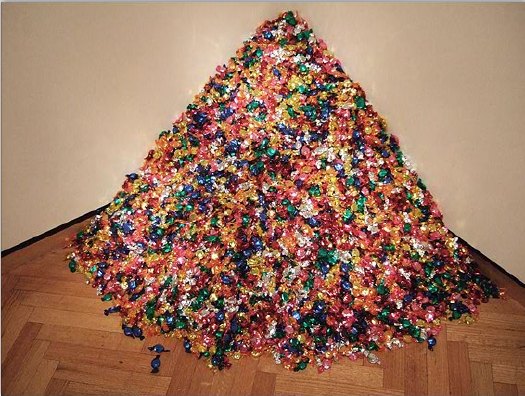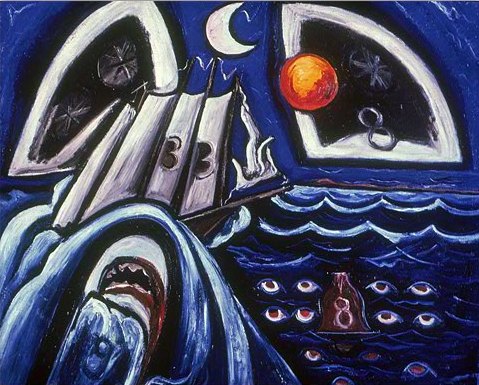
I recently went with my daughters to see “Hide/Seek” at The National Portrait Gallery. They’re 2 and 6, so most of the content of the show is way over their heads. [Much of the work, like the vintage photographs, was literally over their heads.]
Felix Gonzalez-Torres’ shiny, multi-colored candy pour, Untitled (Portrait of Ross in LA) was an immediate and repeated hit. As my kids were going back for “just one more piece,” I laughed with other visitors at the sign the museum had posted next to it, warning that these small candies might pose a choke hazard.
At first I was going to write that we mostly stuck to the bright, colorful works, but that’s not correct. While a giant camo Warhol was front and center, and the kids both recognized it immediately, I didn’t think either one would be ready for the most colorful work in the show, A.A. Bronson’s massive, epic portrait of his AIDS-ravaged partner Felix’s body. Fortunately, the curators had placed it in its own semi-enclosed niche, to the side. It was a careful presentation of a devastating and important work, thoughtfully non-confrontational without seeming sequestered or hidden.
We saw Jasper Johns’ face on a plate. Larry Rivers’ giant nude portrait of Frank O’Hara, which was hard to miss, of course. We played I Spy with some of Marsden Hartley’s elements–the ship, the waves, the bells, the sun &moon, the shark–in his Memorial for Hart Crane. The older kid read the title, so we talked about the painting for his friend who drowned. I couldn’t not tell her that Crane had jumped from the ship, not fallen. No, I didn’t know why, except that he must have been very, very sad and thought that his life was so bad, it’d be better to be dead. Which we decided did not make sense and was not true.
We saw the lady in the tuxedo and laughed at the very idea that long ago, some people thought only men could do things like work, or vote, or paint. And that there were things people thought only women do that men shouldn’t–like pose nude for a painting [gesture to giant, nude Frank O’Hara].
We talked about David Wojnarowicz’s self-portrait, above. And that when he knew he was dying, he made a picture that looked like he was buried. Or maybe it looked like he was coming out of the ground.
There were two small video monitors and a touchscreen, which attracted the 2yo like a giant iPad, but we didn’t come to a museum to watch TV [this time.] One turns out to have been an excerpt from the David Wojnarowicz film, A Fire In My Belly, which the NPG just censored on the demand of William Donohue of the Catholic League, the self-appointed arbiter of offenses to Christian sensibilities. Republican leaders in the House of Representatives seized on the work and the show and demanded the Smithsonian cancel it immediately.
Pulling Wojnarowicz’s work in the face of such bullying is a breathtakingly cowardly betrayal by the museum, one which either ignores or mocks the artist’s own work and history. That it’s happening on World AIDS Day, that Wojnarowicz’ work is singled out for silencing on what used to be called A Day Without Art, is deeply offensive and damaging to the artist, the show, the curators, the museum, and to the principles of our country.
From Michael Kimmelman’s obituary for Wojnarowicz in 1992:
Like the artist himself, his art never pulled punches. Mr. Wojnarowicz gained the national spotlight in 1989, when the National Endowment for the Arts decided to rescind money for a catalogue to an exhibition about AIDS because of an essay in which he attacked various public figures. The endowment reversed itself. It also supported a 10-year retrospective of his work that was organized at the University Galleries of Illinois State University in Normal, Ill., which included a catalogue that reproduced the essay.
Mr. Wojnarowicz was in the news again after the American Family Association of Tupelo, Miss., an antipornography lobbying group, and its leader, the Rev. Donald E. Wildmon, issued a pamphlet criticizing the endowment. The pamphlet included photographs cropped from works by Mr. Wojnarowicz that included sexual images. The artist sued the organization for misrepresenting him and damaging his reputation. In 1990, a Federal District Court judge in New York ruled in his favor and ordered that the organization publish and distribute a correction. Mr. Wojnarowicz was the only artist to challenge Mr. Wildmon in court.
If the exact same people and groups attack the exact same artists and institutions and outcome is actually more punitive–remember, the NEA reversed itself and Wojnarowicz stood up to his critics and won–how can we call it progress? It doesn’t get better by itself.
update: Incredible. Tyler’s confirmed [2024: link updated] that it was Smithsonian Secretary Wayne Clough who ordered the Wojnarowicz video pulled. From the way it went down, it sounds like he censored the video over the objections of the NPG staff–and without even watching it himself. Not that the content is at all obscene or even offensive. To anyone whose job isn’t professional offensetaker, that is.
